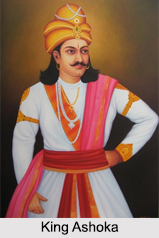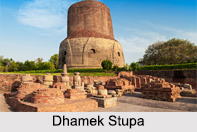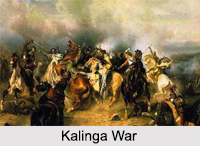 Ashoka was the 3rd ruler of the notable Maurya Dynasty and was one of the most powerful kings of the Indian subcontinent in primordial times. He lived from 304 to 232 BCE. Ashoka ruled form 268 BCE to 232 BCE and became a model of kingship in the Buddhist tradition. He was the last major emperor of the Mauryan Dynasty of India. Ashoka is remembered as one of early history`s most cruelly aggressive rulers of the province. Though, later he turned to be a follower of Buddhist non-violence concept after witnessing the destruction of his attack against the Kalinga area.
Ashoka was the 3rd ruler of the notable Maurya Dynasty and was one of the most powerful kings of the Indian subcontinent in primordial times. He lived from 304 to 232 BCE. Ashoka ruled form 268 BCE to 232 BCE and became a model of kingship in the Buddhist tradition. He was the last major emperor of the Mauryan Dynasty of India. Ashoka is remembered as one of early history`s most cruelly aggressive rulers of the province. Though, later he turned to be a follower of Buddhist non-violence concept after witnessing the destruction of his attack against the Kalinga area.
Early Life of Ashoka
Ashoka was born to the Mauryan king, Bindusara and Subhadrangi. He was the grandson of Chandragupta Maurya, originator of the Maurya Dynasty. Ashoka received a lower position by the virtue of his mother"s status which was consigned to a lower position in the royal household due to internal politics. Ashoka showed great promise in the field of arms skills as well as academics right from his childhood days. Ashoka"s father Bindusara was amazed with his skills and knowledge and appointed him as the Governor of Avanti.
 Soon, Asoka grew into a brilliant warrior general and a judicious statesman. His charge on the Mauryan army started to grow day by day. Ashoka"s elder brothers became jealous of his deeds and they supposed him as being favoured by King Bindusara. Sushim provoked Bindusara against Ashoka which resulted in Ashoka"s exile from Pataliputra to Taxila. This period lasted for 2 years. When Ashoka reached the Taxila province, the militias welcomed him with open arms. This is the phase when Ashoka met Kaurwaki, a fisherwoman and one of his wives.
Soon, Asoka grew into a brilliant warrior general and a judicious statesman. His charge on the Mauryan army started to grow day by day. Ashoka"s elder brothers became jealous of his deeds and they supposed him as being favoured by King Bindusara. Sushim provoked Bindusara against Ashoka which resulted in Ashoka"s exile from Pataliputra to Taxila. This period lasted for 2 years. When Ashoka reached the Taxila province, the militias welcomed him with open arms. This is the phase when Ashoka met Kaurwaki, a fisherwoman and one of his wives.
Ashoka"s Introduction to Buddhism
Emperor Bindusara called back Ashoka from the exile and sent him to Ujjain as the place started witnessing a brutal disturbance. At the age 18, Ashoka was sent to Ujjain as a viceroy. Ashoka was injured in the following battle at Ujjain and was treated by Buddhist monks and nuns. It was in Ujjain that Asoka first came to know about the life and teachings of Buddha.
Following Bindusara"s death in 272 B.C., Ashoka defeated and killed his brothers, including Sushima. Ashoka left his first wife Devi in Ujjain itself, when he was called back in Pataliputra again. Among all his brothers, he only saved his younger brother Vithashoka.
Legacy of Emperor Ashoka
When Ashoka ascended the throne in 272 BC, he had to wait for many years for his coronation in 269 BC to become the 3rd ruler of the Mauryan Empire. He was supported by his father"s ministers, particularly by Radhagupta. Ashoka was continually at war in the first 8 years of his supremacy, growing his empire across the Indian subcontinent. The blood-spattered war at Kalinga left over around 100,000 soldiers and civilians dead and more than around 150,000 were exiled. This major killing of humans shocked Ashoka so much that he promised never to fight again and started practicing non-violence.
Personal Life of Ashoka
According to the legends, Ashoka is believed to have had five wives namely; Devi, Kaurwaki, Asandhimitra, Padmavati and Tishyarakshita. He is believed to have had four sons and two daughters.
Edicts of Ashoka
 Ashoka wrote out a series of laws with the explanations of his policies and objectives of the empire. He urged others to pursue his enlighten illustrations. These are carved onto the pillars of stone 40 to 50 feet high and set up all around the borders of the Mauryan Empire. Dozens of these pillars marked the landscapes of India, Nepal, Pakistan and Afghanistan.
Ashoka wrote out a series of laws with the explanations of his policies and objectives of the empire. He urged others to pursue his enlighten illustrations. These are carved onto the pillars of stone 40 to 50 feet high and set up all around the borders of the Mauryan Empire. Dozens of these pillars marked the landscapes of India, Nepal, Pakistan and Afghanistan.
Contribution of Ashoka in Indian Sculpture
Ashoka is said to have built 84,000 stupas to store the remnants of Lord Buddha and also as places of meditation, across South Asia and Central Asia for Buddhist monks. He directed the construction of a sculpture of 4 lions standing back to back which is known as the Lion Capital of Ashoka. It is situated as the Ashoka pillar at Sarnath, Uttar Pradesh. It is the national emblem of India. Ashoka is also said to have overseen the structure of "viharas"- Nalanda University and Taxila University, stupas - Dhamek stupa, Bharhut stupa, Sanchi, Sannati stupa, Butkara stupa, Barabar Caves and Mahabodhi Temple. The Ashoka Chakra (the wheel of Ashoka) is a representation of the Dharmachakra which was created by Ashoka in his reign.
After ruling over the Indian subcontinent for a period of approximately 40 years, Ashoka died on 232 BC, at the age of 72. After his death, his empire lasted just 50 more years.



















